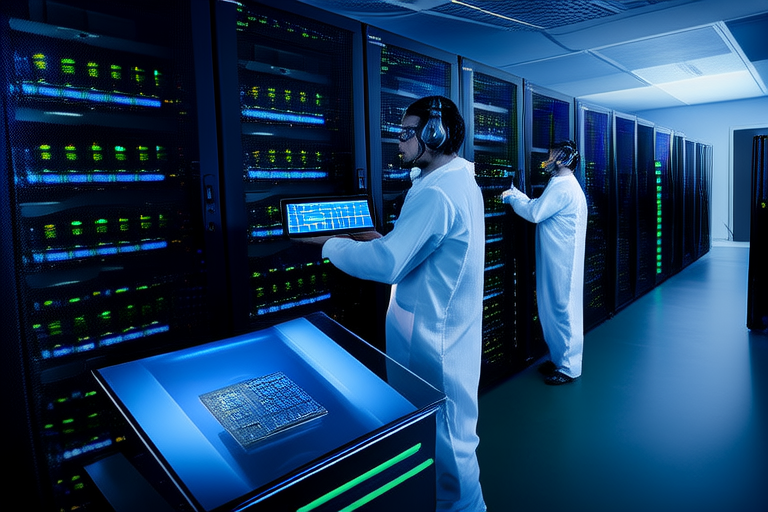“`html
How Cloud and Edge Computing are Revolutionizing Data Processing
Introduction
In today’s data-driven world, the rapid advancement of technology has brought forth two pivotal concepts: cloud computing and edge computing. Cloud computing refers to the delivery of computing services—such as servers, storage, databases, networking, software, and intelligence—over the internet (“the cloud”). This approach allows organizations to store and process data remotely, offering unparalleled flexibility and scalability.
Edge computing, on the other hand, involves processing data closer to where it is generated—often at the “edge” of the network. By reducing the distance between data source and computation, edge computing minimizes latency and enhances real-time processing capabilities. The combination of these two technologies is particularly significant because they address different but complementary aspects of data processing, thereby providing a robust solution for handling the vast amounts of data generated by modern applications.
The synergy between cloud and edge computing offers numerous benefits, including improved efficiency, enhanced scalability, and real-time processing capabilities. These advantages are crucial in industries ranging from healthcare to manufacturing, enabling faster decision-making and more effective resource management.
Understanding Cloud Computing
Cloud computing plays a central role in modern data processing by offering scalable and flexible resources that can be accessed over the internet. Cloud services come in three primary forms: Infrastructure as a Service (IaaS), Platform as a Service (PaaS), and Software as a Service (SaaS). IaaS provides virtualized computing resources over the internet, allowing users to rent computing power, storage space, and other resources. PaaS offers developers the necessary tools and frameworks to build, test, and deploy applications. SaaS, meanwhile, delivers software applications over the internet, eliminating the need for local installation.
The transformation of traditional IT infrastructure through cloud services has been profound. Organizations can now scale their resources up or down based on demand, reducing costs and increasing operational efficiency. For example, big data analytics firms leverage cloud platforms to handle massive datasets, while machine learning startups utilize cloud-based tools to train complex models. Additionally, cloud storage solutions provide reliable and secure repositories for sensitive information.
Industries benefiting from cloud computing include finance, healthcare, retail, and telecommunications. In finance, cloud-based systems enable real-time fraud detection and risk assessment. Healthcare providers use cloud platforms to manage electronic health records and facilitate telemedicine services. Retailers rely on cloud computing for inventory management and customer relationship management. Telecommunications companies leverage cloud infrastructure to offer advanced communication services.
Exploring Edge Computing
Edge computing processes data closer to where it is generated, significantly reducing latency and enhancing local processing power. This approach is particularly beneficial for applications requiring immediate responses, such as IoT devices, autonomous vehicles, and smart cities. By minimizing the distance between data source and computation, edge computing ensures faster and more efficient data processing.
Compared to cloud computing, edge computing focuses on reducing latency and improving local processing speed. While cloud computing centralizes data processing in remote data centers, edge computing distributes processing power across various nodes within the network. This distribution enables faster response times and reduces the load on centralized cloud infrastructure.
Use cases for edge computing abound. In IoT, edge computing allows devices to process data locally, reducing the need for constant communication with a central server. Autonomous vehicles rely on edge computing to make split-second decisions based on sensor data. Smart cities employ edge computing to manage traffic flow, optimize energy usage, and enhance public safety. Other applications include predictive maintenance in manufacturing, real-time analytics in sports, and personalized experiences in entertainment.
Synergy Between Cloud and Edge Computing
The true power of cloud and edge computing lies in their ability to complement each other. Cloud computing provides the necessary infrastructure and computational resources for large-scale data processing, while edge computing ensures real-time processing and reduced latency. Together, they create a hybrid architecture that integrates both cloud and edge functionalities, offering the best of both worlds.
Hybrid architectures combine the strengths of cloud and edge computing to deliver optimal performance. For instance, edge devices can preprocess data and send only relevant information to the cloud for further analysis. This approach not only reduces bandwidth consumption but also enhances data privacy and security. Advanced technologies like 5G, AI, and IoT are driving this integration, enabling seamless communication between edge devices and cloud platforms.
Several companies and industries have successfully leveraged both cloud and edge computing. For example, Amazon Web Services (AWS) offers AWS Greengrass, a service that extends cloud capabilities to edge devices. Google Cloud provides Anthos, a platform that enables consistent deployment and management of applications across multi-cloud and on-premises environments. Industries such as telecommunications, automotive, and manufacturing are increasingly adopting hybrid architectures to improve operational efficiency and customer satisfaction.
Challenges and Future Prospects
Despite the numerous benefits, adopting cloud and edge computing comes with its share of challenges. Security concerns remain a top priority, as distributed architectures increase the attack surface. Interoperability issues may arise when integrating diverse systems and protocols. Cost implications can also be a barrier, especially for small and medium-sized enterprises. However, ongoing advancements in technology and industry standards are addressing these challenges.
Future trends in cloud-edge collaboration include increased automation, enhanced privacy measures, and more sophisticated algorithms. As 5G networks become more widespread, the integration of cloud and edge computing will accelerate, enabling faster and more reliable data transmission. AI and machine learning will play a crucial role in optimizing resource allocation and improving system performance. Enhanced privacy measures, such as differential privacy and homomorphic encryption, will ensure data protection while maintaining functionality.
Over the next decade, we can expect cloud and edge computing to evolve further, becoming even more integral to everyday life. The convergence of these technologies will reshape the landscape of data processing, offering new opportunities and challenges for businesses and individuals alike.
Conclusion
The combination of cloud and edge computing is revolutionizing data processing by offering unprecedented efficiency, scalability, and real-time capabilities. Cloud computing provides the necessary infrastructure and resources for large-scale data processing, while edge computing ensures real-time processing and reduced latency. Together, they create a powerful synergy that is reshaping industries and enhancing user experiences.
As we look to the future, the continued development of cloud and edge computing will bring about exciting innovations and improvements. Businesses and individuals should consider the implications of these technologies for their operations and personal lives, ensuring they stay ahead in an increasingly digital world.
“`


